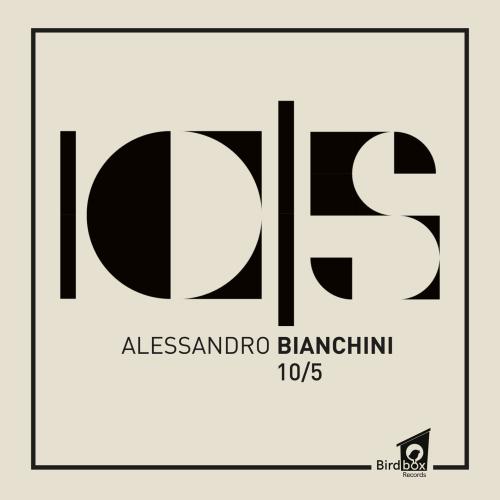
10/5 Alessandro Bianchini
Album info
Album-Release:
2023
HRA-Release:
17.10.2023
Album including Album cover
- 1 Invitation 06:49
- 2 Song for peace 04:12
- 3 Mud for Bud 02:46
- 4 10/5 06:15
- 5 Alice 03:31
- 6 Bud Powell 03:37
- 7 Grazie Armando 03:18
Info for 10/5
The record is the outcome of a cross-contamination stemming from different genres and styles, reflecting Alessandro Bianchini’s musical education: from the typical academicism of classical music to improvisation, through the sounds of traditional jazz.
These elements mark indelibly the vibraphonist’s aesthetics and musical language, which are then embellished by a constant and meticulous search for detail, as such allowing his compositions to be identified.
When asked about his music he says: "The timbral choice of the mallets that change according to the song, the idea of putting vibraphone and marimba together, and the almost maniacal emphasis on dynamics are the elements that, in my opinion, give the record a jazzy sound, with important and recognizable deliberately refined elements. Another aspect is certainly evident to listeners, namely the presence of an element that I personally always place in the foreground and that is the basis of improvisation and interplay: Timing. It is precisely the timing that allowed me to create a natural, almost instinctive feeling with the other members of the group: Marco Micheli on double bass and Simone Brilli on drums".
Brief description of the songs:
"Invitation" The choice to arrange this jazz standard stems from a desire to include rhythmic and timbral elements of one of the most significant pieces of the bop repertoire. This standard was composed by Kaper, an outstanding composer of the American jazz scene of the 1900s. Although it is a piece from 1952, it immediately seemed to me to be very up to date, almost as if it were a contemporary composition. The arrangement creates free moments in the Intro and Outro, which both encourage musical exploration and lend spontaneity to improvisation and interplay among the musicians in the trio. From the very first notes one can immediately perceive the contaminations of percussive, almost prehistoric, tribal music.
"Song for peace" Classic jazz waltz, inspired by the sounds and Interplay typical of Bill Evans' early piano trio, with Scott LaFaro on double bass and Paul Motian on drums. In the song, moreover, the melodic lines are with no doubt influenced [VA1] from another composer who has had and still has much importance in my musical aesthetics, Johann Sebastian Bach.
"Mud for Bud" is in its essence a tribute to the two musicians who marked my studies of the bebop repertoire: Charlie Parker, and Bud Powell. The former a saxophonist, the latter a pianist. The harmonic structure and form are nothing more than a counterfeit of "Donna Lee" one of the manifesto songs of the bebop era, however, with a deliberate shift away from the original tone. "Mud for Bud" is in Eb Maj as opposed to Donna Lee which is in Ab Maj. In the last vibraphone solo chorus, part of the original theme of the song made famous by Bird is quoted.
"10/5" is the song that gives the album its name, drawing inspiration from Egberto Gismonti's repertoire, inspiring composer for me. The title is given by the metric that drives the music, in the sense that it can be counted and interpreted either in 5/4 or 10/16. In my opinion, it is the most intense composition, being the result of a melodic line created on a 5/4 clave, which is always present as a groove in the development of both themes and improvisation. From a composition point of view, the A section differs from the B section only in a change of harmonic rhythm, while keeping the thematic line unchanged.
"Alice", dedicated to my wife, is a traditional ballad with interferences of post-bop tension. This track features the extraordinary participation of Beatrice Sberna on the voice.
"Bud Powell" This jazz standard captures two great passions of mine. The bebop language and the compositional mastery of one of my favorite pianists in contemporary jazz, Chick Corea. The song is dedicated to Bud Powell, an infinite artist for me, and is encapsulated on an album entirely dedicated to the pianist who died early, entitled "Remember Bud Powell" (Stretch label 1997).
"Grazie Armando" is a piece designed for and dedicated to Chick Corea and is infused with timbres and grooves typical of the Latin jazz repertoire. The dynamism of the composition is given by the alternation in the themes of the two instruments: the vibraphone and the marimba. The introduction is played on the vibraphone and then switches to the marimba, where the theme is played in the lowest register of the instrument. This creates a sharp contrast with the vibraphone solo, making listening smooth but at the same time dynamic.
10/5 was recorded in early February 2023, at Andrea Scardovi's Duna Studio in Russi, Ravenna. The recording session lasted a total of three hours, in which the trio recorded a maximum of two takes per track.
Five out of seven tracks were composed and arranged by Alessandro Bianchini, while the first and sixth tracks on the record are two jazz standards re-arranged for the trio's lineup: vibraphone/marimba, double bass, and drums.
The record is strongly permeated with the typical stylistic features of traditional jazz and is the result of a musical language and aesthetic matured over the years by the vibraphonist.
Alessandro Bianchini, vibraphone, marimba
Simone Brilli, drums
Marco Micheli, double bass
Special guest:
Beatrice Sberna, vocals (on 10/5; Alice)
No biography found.
This album contains no booklet.









